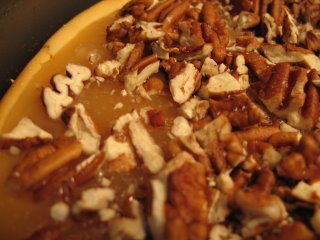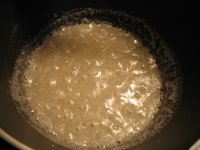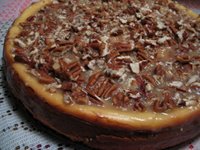Adventures in Catering
 A few months ago, long before culinary school final exams were a worry to be fretted, the Engineer's mom asked me to cater a small party she would be throwing in honor of a friend's 50th birthday. This party was going to be in July (ie, last weekend), but she knows me very well and wanted to give me plenty of advanced notice. She's a swell lady.
A few months ago, long before culinary school final exams were a worry to be fretted, the Engineer's mom asked me to cater a small party she would be throwing in honor of a friend's 50th birthday. This party was going to be in July (ie, last weekend), but she knows me very well and wanted to give me plenty of advanced notice. She's a swell lady.
Of course, I accepted and immediately started making lists, mining my trove of Successful Recipes for ideas, doubting my culinary prowess, trying (unsuccessfully) to convince Mama Engineer that I wasn't nearly skilled enough to cater her party, and generally getting excited about the whole thing.
It turned out to be quite a lot of fun and rewarding in that "take a step back, fold your arms over your apron, and sigh deeply while people enjoy food you cooked" kind of way. Also to my complete and utter surprise, it was not at all stressful! Shocker!
It was a mid-afternoon party of about 40 people (although about half that number actually turned out). We were planning four main dishes--two salads, a cold soup, and a hot dish--with other little snacks scattered around the room. Here was our final line-up:
- Arugula Vichyssoise--from Epicurious
- Beet and Feta Salad in Endive Cups--from a recipe I did for the Kitchn
- Gorgonzola and Walnut Tortellini Salad
- BBQ Pulled Pork--from a recipe I found over at Andrea's Recipes
- Brioche Buns (to go with the pulled pork)--from Artisan Bread in Five Minutes A Day
 On the plus side, the Engineer and I awoke Saturday morning to the sweet smell of barbecue. Let me assure you that barbecue smells just as mouth-watering at 8am as it does any other time of the day. I had to slap the Engineer's hands a few times to get him to back off and make some bacon instead.
On the plus side, the Engineer and I awoke Saturday morning to the sweet smell of barbecue. Let me assure you that barbecue smells just as mouth-watering at 8am as it does any other time of the day. I had to slap the Engineer's hands a few times to get him to back off and make some bacon instead.These brioche buns were my favorite thing to make. My house smelled like a bakery. They should make candles that smell like that. Or else I might have to make these buns every day.
 The recipe is from Artisan Bread in Five Minutes a Day, which if you haven't discovered it yet, is the best book ever for bakers on the go. I made their master recipe here on the blog a few months ago, and have since reviewed the book at the Kitchn. It's full of excellent recipes that are really just...well, good! Don't get me wrong--I love my sourdoughs with the preferments and the kneading and all that lovely stuff. It just that...sometimes...you need a quick loaf to get you through the week or to impress some new friends or something like that.
The recipe is from Artisan Bread in Five Minutes a Day, which if you haven't discovered it yet, is the best book ever for bakers on the go. I made their master recipe here on the blog a few months ago, and have since reviewed the book at the Kitchn. It's full of excellent recipes that are really just...well, good! Don't get me wrong--I love my sourdoughs with the preferments and the kneading and all that lovely stuff. It just that...sometimes...you need a quick loaf to get you through the week or to impress some new friends or something like that.Anyways. These brioche buns are very good. The texture isn't quite as fine as brioche that I've made the long way, but I'm not telling. For sandwiches like pulled pork, they were perfect.
The salads were both a hit. The walnut-gorgonzola salad is just a solid mix of flavors. The gorgonzola is actually in the tortellini--purchased from Trader Joe's and consumed shamelessly by this particular chef. I threw in toasted walnuts for some extra walnut flavor (the gorgonzola kinda overpowers it in the tortellini, which is honestly fine by me), along with apples, argula, and caramelized onions. The dressing is a simple balsamic.
 I loved the little endive scoops with the beet salad. They were so much fun to eat! Also, I'm pretty sure I've made that beet salad in one form or another every week this summer. It's that good. Go forth and make it.
I loved the little endive scoops with the beet salad. They were so much fun to eat! Also, I'm pretty sure I've made that beet salad in one form or another every week this summer. It's that good. Go forth and make it. The only recipe I wasn't thrilled with was the argula vichyssoise. It tasted a bit flat and bland to me. I made it a few times and fussed with the recipe (especially by adding lemon), but never got it quite right. (Oh, my review of the recipe is over at the Kitchn, though reading it again now, I think I was a bit generous.) I came across another cold soup recipe the other day that used yogurt, and another one today that used buttermilk. I'm wondering if either of these would help give the soup a better flavor.
The only recipe I wasn't thrilled with was the argula vichyssoise. It tasted a bit flat and bland to me. I made it a few times and fussed with the recipe (especially by adding lemon), but never got it quite right. (Oh, my review of the recipe is over at the Kitchn, though reading it again now, I think I was a bit generous.) I came across another cold soup recipe the other day that used yogurt, and another one today that used buttermilk. I'm wondering if either of these would help give the soup a better flavor.Maybe it's just that I don't really like vichyssoise or potato-leek soup in general. Or cold soups for that matter. Or pureed soups, either, now that you mention it. Huh. Mama Engineer loved it, though, so that's what really matters.
Operation Catering-for-Mama: Success! While I probably could have done something like this before culinary school, I definitely recognized how much more confident and relaxed I felt. That's definitely affirming. Pats on the back all around.
Ok, who's up for some breakfast barbecue?!











































